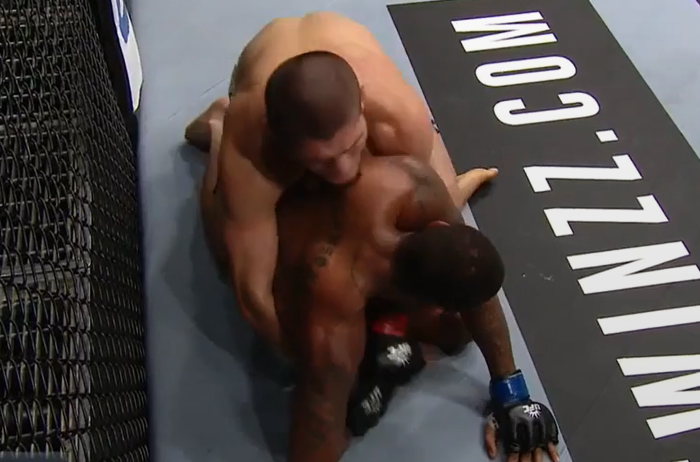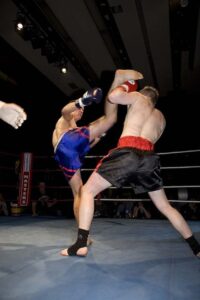
Have you heard the UFC commentators mention the Dagestani handcuff during a UFC fight and are wondering what it is?
In this article, we’ll explain what the Dagestani handcuff is, why MMA/UFC fighters like Khabib use the Dagestani Handcuff, the origins of the Dagestani Handcuff, how to escape a Dagestani handcuff,
Contents
What Is the Dagestani Handcuff Used by Khabib and UFC/MMA Fighters?
The Dagestani Handcuff is a wrestling technique used in UFC/MMA where a fighter uses both hands to pin an opponent’s wrist/forearm between the ground and their body, thereby immobilizing and controlling them.
The Dagestani Handcuff can be applied from the top position, side control, or even when the opponent is in a turtle position.
With their arm trapped between the ground and their body, the opponent can attempt to recover and post on their trapped arm, defend against strikes with their free hand, or scramble to prevent worse positioning.
The Dagestani Handcuff is most often applied in half guard after an opponent is taken to the ground.
They’ll drag the opponent on their side and reach around their back and under their arm to grab the forearm/elbow. The other hand then grabs the wrist.
This is then yanked down toward the opponent’s body and the body is pushed down toward the wrist by making them carry the weight with head positioning, hip riding, and locking the legs.
Here’s a 1-minute video showing how Khabib Nurmagomedov used the Dagestani Handcuff:
With the opponent’s arm controlled and trapped against their own body, the controller can let go of the grip with the hand on the open side to unleash strikes.
If the opponent gets their hand free and tries to post on it, the controller stops striking and again uses two hands against one to yank the opponent’s hand down and pin it underneath their body before repeating the process.
With the opponent tiring and expecting to be Dagestani Handcuffed again, the option to advance position or go for submission is presented. Here, most Dagestani fighters move to full mount or a body triangle lock.
Note: The Dagestani Handcuff has nothing to do with pinning a fighter’s arm behind their back. Most times, a Dagestani Handcuff has an opponent’s hand trapped between the ground and the side of their body.
Why Do MMA/UFC Fighters Use the Dagestani Handcuff?
MMA/UFC fighters use the Dagestani Handcuff because it’s highly effective for controlling an opponent on the ground and using the free hand to strike or transition to a submission.
MMA/UFC fighters can win rounds quite easily by controlling an opponent on the ground and racking up control time, and the Dagestani Handcuff is perfect for this as it stops an opponent from posting with their hands.
Overall, the Dagestani Handcuff is a two-for-one deal as it allows for control and scoring points/damage.
Origins of the Dagestani Handcuff
The Dagestani Handcuff originates from collegiate/folkstyle wrestling where it’s known as a wrist ride.
The wrist ride is a wrestling technique where a wrestler controls their opponent’s wrist (aka wrist control) to limit their movement and control their actions – most often on the ground from the top position.
A wrist ride focuses on controlling an opponent’s wrist to prevent them from building a base or posturing up. This allows a grappler to maintain top control, prevent escapes, and set up pins or transitions to other dominant positions.
The difference between a wrist ride and a Dagestani Handcuff is the Dagestani Handcuff’s emphasis on getting the opponent’s hand/arm to a pin position by using a two vs. one drag.
The wrist ride was coined the Dagestani Handcuff after Dagestani fighter, Khabib Nurmagomedov, made the technique famous during his undefeated MMA and UFC career.
He constantly used the Dagestani Handcuff to control his opponents on the ground, advance positions, and leave them open to strikes and submission attempts.
Khabib famously used the Dagestani Handcuff in devastating fashion in his fights against Michael Johnson, Dustin Poirier, and Edson Barboza to name a few – all of whom you can see in this video.
Dagestani MMA/UFC fighters use the Dagestani Handcuff because they have strong wrestling and combat sambo backgrounds, where the technique is used heavily.
It’s also a popular technique in submission grappling as it presents openings for submission attempts, usually the rear-naked or head-and-arm triangle choke.
When commentating, Daniel Cormier constantly mentions the Dagestani Handcuff because of his wrestling background and love for the art. Dominick Cruz was also very fond of Khabib’s Dagestani Handcuff and grappling control.
Taking it a step further, a wrist ride can be transitioned into a hamerlock. The hammerlock is a wrestling hold where the opponent’s arm is twisted/pushed upwards behind his back to apply pressure to the shoulder joint.
In wrestling, the hammerlock is used to pin an opponent. In submission wrestling, jiu-jitsu, or MMA, it can be turned into a submission due to the pressure on the shoulder joint.
Note: We included the hammerlock hold to make its difference from a Dagestani Handcuff clear.
How To Escape a Dagestani Handcuff in MMA (Step by Step)
The Dagestani Handcuff, while a dominant position, isn’t an endgame. Like every technique in MMA, there’s a counter or escape.
Here’s a step-by-step guide on how to escape a Dagestani Handcuff in MMA:
1. Stay Calm and Breathe: First and foremost, don’t panic. Panicking will only exhaust you faster and make it easier for your opponent to maintain control. Take deep breaths and stay focused.
2. Protect Your Face: With one arm trapped, your face becomes an easy target. Use your free hand to shield your face from potential strikes.
3. Shift Your Weight: Try to shift your weight towards the side of the trapped arm. This movement can create a slight gap, making it harder for your opponent to maintain a tight grip.
4. Free the Trapped Wrist: Use your free hand to grip your opponent’s wrist that’s holding the handcuff. Apply pressure and try to slide your trapped hand out. Remember, it’s a battle of leverage.
5. Base Out with Your Legs: Spread your legs and establish a strong base. This will make it harder for your opponent to maintain control and might give you the leverage needed to turn into them.
6. Turn Into Your Opponent: Once you feel the grip loosening, try to turn into your opponent. This movement can break the handcuff and put you in a more favorable position with the opponent in your guard.
Overall
Like all techniques, the more you practice the escape, the better you’ll get at it.
Regularly train with partners who can apply the Dagestani Handcuff, so you become familiar with the feeling and can work on your escape in a controlled environment.
Remember, the key to escaping any dominant position, including the Dagestani Handcuff, is to first defend yourself from strikes and submissions, stay calm, think clearly, and use technique over brute strength.
With practice and patience, you’ll find yourself slipping out of this tricky position with ease.
The Bottom Line
The Dagestani Handcuff is a wrestling technique used in UFC/MMA where a fighter uses both hands to pin an opponent’s wrist/forearm between the ground and their body, thereby immobilizing and controlling them.
This allows them to control their opponent while landing ground and pound to score points or score a TKO victory.
The control time can be an effective way to win via decision and it also opens the opportunity for submissions when the fighter attempts to get their hand free.
Not only submissions, but more commonly a UFC fighter will take the opportunity to advance to a more advantageous position such as a back triangle lock or full mount where they can more easily get the finish.




